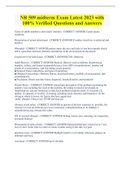NR 509 midterm Exam Latest 2023 with
100% Verified Questions and Answers
Cause of saddle numbness and urinary retention - CORRECT ANSWER Cauda equina
syndrome
Presentation of retinal detachment - CORRECT ANSWER If sudden visual loss is unilateral and
painless,
Obtunded - CORRECT ANSWER patient opens the eyes and looks at you but responds slowly
and is somewhat confused. Alertness and interest in the environment are decreased.
Cranial nerve for lateral gaze - CORRECT ANSWER CN6: Abducens
Adult Illnesses - CORRECT ANSWER Medical: Illnesses such as diabetes, hypertension,
hepatitis, asthma, and human immunodeficiency virus (HIV); hospitalizations; number and
gender of sexual partners; and risk-taking sexual practices
■ Surgical: Dates, indications, and types of operations
■ Obstetric/Gynecologic: Obstetric history, menstrual history, methods of contraception, and
sexual function
■ Psychiatric: Illness and time frame, diagnoses, hospitalizations, and treatments
Present Illness - CORRECT ANSWER chronologic description of the problems prompting the
patient's visit, including the onset of the problem, the setting in which it developed, its
manifestations, and any treatments to date.Each problem/symptom needs: (1) location; (2)
quality; (3) quantity or severity; (4) timing, including onset, duration, and frequency; (5) the
setting in which it occurs; (6) factors that have aggravated
-meds, allergies, tobacco use, ETOH and drug use
Absence of red reflex - CORRECT ANSWER an opacity of the lens (cataract) or, possibly, the
vitreous (or even an artificial eye). Less commonly, a detached retina or, in children, a
retinoblastoma may obscure this reflex.
S/S of seasonal allergies - CORRECT ANSWER Itching, watery eyes, sneezing, ear congestion,
postnasal drainage
Presentation of optic neuritis - CORRECT ANSWER Enlarged blind spot, vision loss in 1 eye,
loss of color vision, hole in center of vision, trouble seeing to the side, eye pain
pityriasis rosea - CORRECT ANSWER Multiple round to oval scaling violaceous plaques on
abdomen and back
Acromion - CORRECT ANSWER tip of shoulder
, What to do for + finding on physical exam, but - workup - CORRECT ANSWER continue using
test, but less lab and diagnostics
Cause of falsely high BP - CORRECT ANSWER -too small of a BP cuff
- if the brachial artery is below heart level
- loose cuff
- bladder that balloons outside the cuff
Check for nystagmus - CORRECT ANSWER -involuntary jerking movement of the eyes with
quick and slow components.
- It is named for the direction of the quick component
- seen in cerebellar disease and vestibular disorders and in internuclear ophthalmoplegia
Jaundice - CORRECT ANSWER yellow sclera
how do get a patient to open up when upset - CORRECT ANSWER effective reassurance is
simply identifying and acknowledging the patient's feelings.
-Partnering
-Summarizing
-Transitions
- Empowering the pt
s/s of degenerative pain - CORRECT ANSWER -Slowly progressive, with temporary
exacerbations after periods of overuse
-usually insidious
- flexion and deviation deformities
How otosclerosis presents with Weber and Rinne test - CORRECT ANSWER - Weber: Sound
lateralizes to impaired ear. Room noise not well heard, so detection of vibrations improves
- Rinne: BC longer than or equal to AC. While air conduction through the external or middle ear
is impaired, vibrations through bone bypass the problem to reach the cochlea.
Cherry angiomas - CORRECT ANSWER Benign
Interpreting visual acuity test - CORRECT ANSWER Vision of 20/200 means that at 20 feet the
patient can read print that a person with normal vision could read at 200 feet. The larger the
second number, the worse the vision. "20/40 corrected" means the patient could read the 20/40
line with glasses (a correction).
Sequence of the interview - CORRECT ANSWER Preparation. Then, Greeting the patient and
establishing rapport. Establishing the agenda for the interview. Inviting the patient's story.
Exploring the patient's perspective. Identifying and responding to emotional cues. Expand-ing
and clarifying the patient's story. Generating and testing diagnostic hypotheses. Sharing the
treatment plan. Closing the interview and the visit. Taking time for self-reflection.




